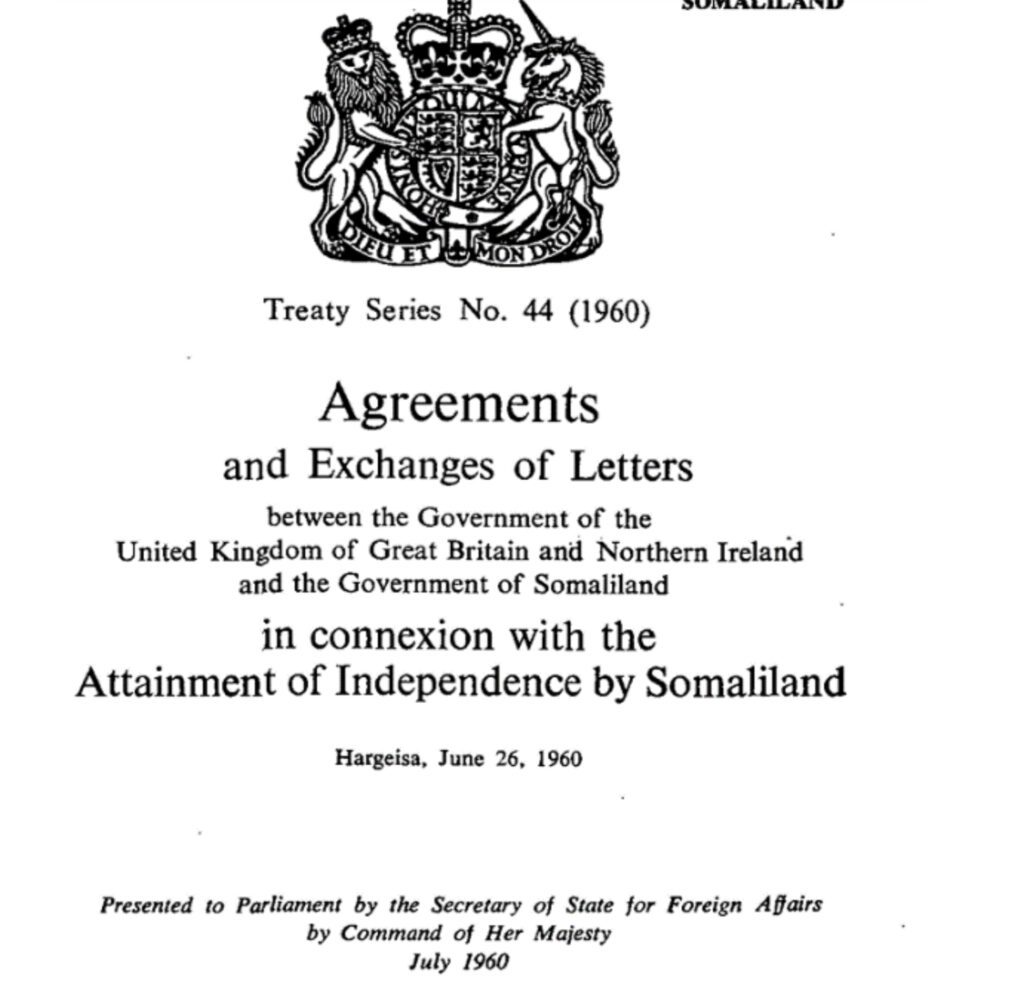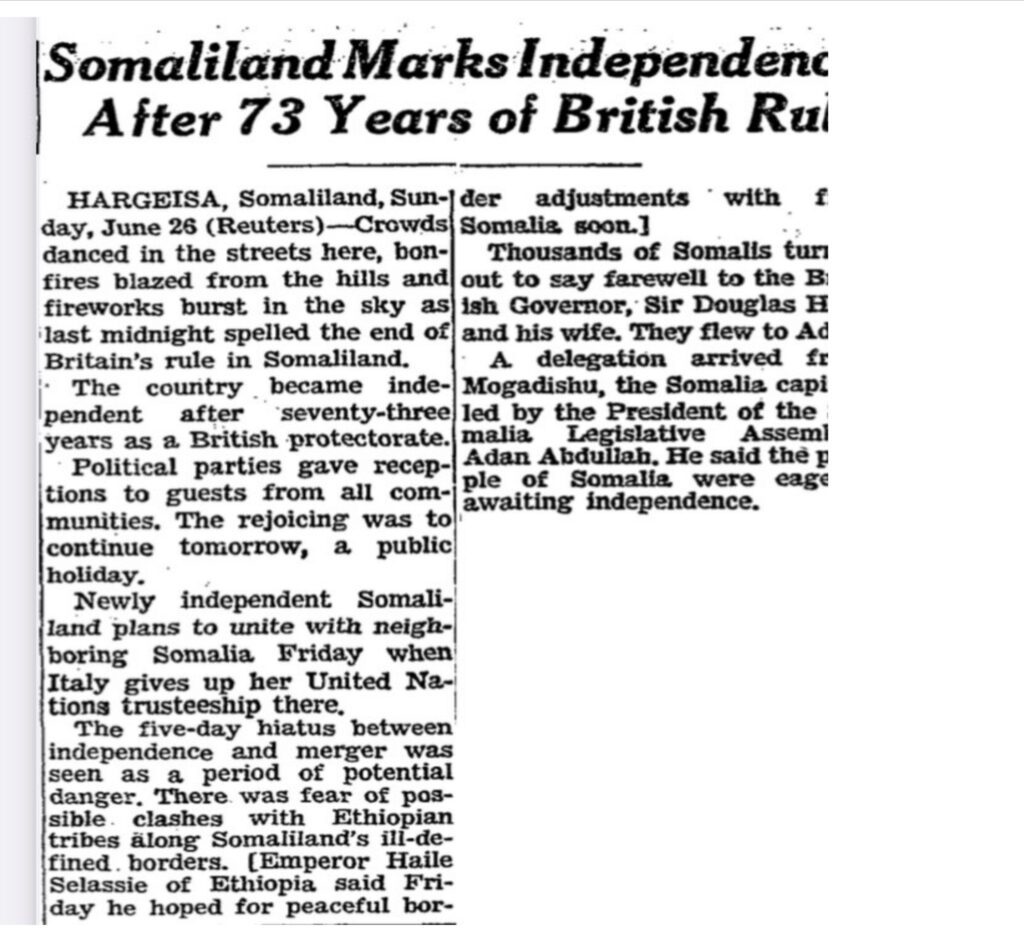According to Said S. Samatar and David D. Laitin (1987, pp. vi-vii), “In Somalia, history is deadly ammunition in today’s political wars. Perhaps the only appropriate analogy to the Somali case is that of Israel, where biblical geography is an important clue in unravelling the skein of conflict among diverse Israeli factions.“
Like most of Africa, Colonial Europe partitioned the Somali Peninsula into five parts. Two of these partitions, Western Somalia and the NFD, were annexed by Ethiopia and Kenya, respectively. The British colony of the Somali peninsula gained independence on June 26, 1960, the French colony on June 27, 1976, and the Italian colony on July 1. For that reason, this week is known as Somali Independence Week.Hence, as Somali Independence Week approaches, Somalis frequently debate the history, legal aspects, and political relevance of secessionists and unionists on social media.

The main argument of the proponents of the secessionistcomprised four points: (1) referring to Gazette no. 42074,that “Somaliland has granted independence through Royal Proclamation Terminating Her Majesty’s Protection, which stated: “whereas it is intended that the Somaliland Protectorate shall become an independent country on 26th June 1960 (hereinafter referred to as “the appointed day.” They add that no credible evidence supports the notion that Britain granted independence to clans. Plus, granting independence to the Tribes had not been raised during the constitutional conference in London in May 1960, but unification with Mogadishu was discussed. (2) Britain did not have a pre-determined plan to unite Somaliland with Somalia on 1st July 1960. (3) Somaliland borders fit to “African States, on the day of their independence, constitute a tangible reality”, stipulated in Cairo, UAR, from 17 to 21st July 1964. (4) 34 countries recognised Somaliland through messages and congratulatory notes. To justify these, they use “Gazette no. 42074” and”Treaty Series No. 44.” 1960, and UN resolution 1514 (XV)as evidence. They also presented an image of a note purportedly claimed to have been sent to Somaliland by the first Premier of the People’s Republic of China, Zhou Enlai.
To set the record straight, this paper provides a clear and accurate account of the incomplete information used by these proponents. It also refutes the cherry-picking of information and irrelevant documents. It provides more pertinent information about the Somali independence days of June and July of 1960. Hence, according to historical records, Somaliland did not attain independence as a unified political entity; instead, the individual clans that had reached agreements with Britain reclaimed their independence. Britain ensured the lapse of the Protectorate, thereby absolving themselves of responsibility. It argues that the items in question were ‘independent’ on the one hand and that the ‘protectorate’ had lapsed on the other, with Great Britain and Northern Ireland and any of the Tribes of the Somaliterritories being parts of the agreement. It then references the African Union, a part of their everyday arguments and concludes by describing the realities that resulted after the Laascaanood conflict in 2023/2024.
The secessionist proponents often partially quoted Gazette no. 42074 by cherry-picking the part that says, “Great Britain and Northern Ireland and any of the Tribes of the said territories, all Our obligations … shall lapse while being too timid to acknowledge that the document was about protection treaties “, omitting that Great Britain and the Tribes were the sole parts of the discourse. See the entire paragraph below.
Now, therefore, We do hereby, by and with the advice of Our Privy Council, proclaim and declare that, as from the beginning of the appointed day, Our protection over the territories known as the Somaliland Protectorate shall cease, and all treaties and agreements in force immediately before the appointed day between Us or Our Government of the United Kingdom of Great Britain and Northern Ireland and any of the Tribes of the said territories, all Our obligations existing immediately before that day towards the said territories and all functions, powers, rights, authority or jurisdiction- exercisable by Us immediately before that day in or in relation to the said territories by Treaty, grant, usage, sufferance or otherwise, shall lapse.
Evidence that the British Government Granted Independence to Tribes
Gazette no. 42074 surrounds two relevant documents that it deduced from and were necessary to read with it: (1) “Reports of the Somaliland Protectorate Constitutional Conference, held in London in May, 1960″ [and] (2) “Treaty Series No. 44 (1960).“ In the former, articles 7 and 10 (page 4) stipulate that 1st July 1960 was the basis of the independence to which the Queen has granted independence “through Royal Proclamation Terminating Her Majesty’s Protection.”
In the Constitutional Conference held in London on 2-5 of May 1960, the Treaties between the British and the Somali tribes were the basis of the conference. Thus, the conference began with a setting of the histories of such Treaties and emphasised six treaties Britain had with the tribes. These are the Gadabursi treaty signed in Zaila on 11th December 1884; the Eesa treaty signed in Zaila on 31st December 1884; the Habr Toljaala treaty signed in Aden on 26th December 1884; the Habr Gerhajis treaty signed in Aden on 13th January 1885; the Habr-Awal Treaty signed in Berbera on 14th July 1884; the Warsangali treaty signed on 27th January 1886 (page 3).
In the BBC broadcast on Thursday, 5th May, 1960, Egal stated that Britain had spent two days (Monday and Tuesday, May 2nd and 3rd, 1960) investigating two main issues. First, they had to determine whether the tribes with which it had treaties wanted their independence. Second, they had to determine whether the delegations they discussed were true representatives of the four major tribes.

Britain had a Pre-determined Plan to Unite Somaliland with Somalia on 1st July 1960.
Britain had a preplanned agenda and wanted to share it with the Protectorate delegation. In his interview on 5th May 1960 on BBC, Egal clearly stated in minutes1:09-1:1:59 that “The UK had already decided its position. However, it sought to ensure whether the public supported the notion, and the result was that we would be independent on 1st July to unite with our fraternalin Somalia.“
Article 7 of the Somaliland Protectorate Constitutional Reportdiscusses the December 1959 General Assembly of the United Nations. The UN adopted a resolution in the assembly stating that Somalia should be under Italian Trusteeship and become independent on 1st July 1960. The UK voted in favour of the resolution. After that, on 6th April 1960, the Protectorate Legislative Council unanimously passed the following resolution:
THAT it is the opinion of this House that practical steps should be taken forthwith for the immediate unification of the Protectorate and Somalia, THAT prompt action is essential to achieve this most cherished aim and can be fully justified by special importance which popular feeling in this country attaches to it is early attachment, THAT a bold and definite action be taken, and THAT the date of independence and unification with Somalia must be 1st July, 1960 the date when Somalia will attain its full freedom.
In article 10 (page 4), the Somaliland “delegation confirmed“that they sought to “unite with Somalia when the country becomes independent on 1st July. The 6th of April 1960 resolution prompted the Colonial Office to hold a conference, which started on “2nd May and lasted until 12th May 1960. In the conference, the colonial subject’s pleading point for pursuing this goal was that the Tribes helped and worked”with the successive British government for 80 years.“Notably, the delegates also asked the UK to continue the relationship after 1st July, when they unite the rest of Somalia.
While the Protectorate hoped for the UK’s help in uniting with Somalia and continuing support, the UK government was working on taking the necessary steps to terminate the protection. Article 12 of the report states that the UK government has sought appropriate action. The UK first considered whether it was obliged or not obliged to give “a written agreement abrogating [the Tribal] treaties (page 5), and the answer was no need to provide one. Second, the UK government wanted to ensure that the Tribes with which it had the treaties would be on board. The reason the Secretary of State “accepted the assurance of the Somaliland delegation[representing Gadabursi 1, Harti 1, and Isaaq 2] that there was an overwhelming majority of national public opinion behind their demand that the authorities of the tribes concerned were in agreement.“ Third, the UK government compelled the Somaliland delegation to “hold a meeting of the Council [Tribal] Elders of the Protectorate on 24th May“ stipulated in Article 13 of the report. Fourth, the protectorates’ grazing rights [of the regions the UK ceded to Ethiopia], “would lapse“ (Article 14).
More to the point, in Article 21, the Secretary of State informed the conference that “in light of the progress made, H.M.G. were now prepared to take further constitutional steps to make possible the independence of the Protectorate by 1stJuly, 1960.” All these are the inference of Lenex-Boyd’s report (page 15) in which article 5 states, “Her Majesty‘s Government are now prepared to take further constitutional steps to make possible the independence of the Protectorate by 1st July.“ Somaliland’s protectorate “would disappear“, as stated in article 14, after it joins Somalia. Hence, despite precise specifications regarding the Protectorate’s independence from the colony, most of the report’s other articles discuss civil servants and colonial workers after 1stJuly. Remarkably, they used the above Treaty Series No. 44 (1960) as a caption and failed to add any flesh. Nonetheless, the document is dated on 26th June. However, it was “Presented to Parliament by the Secretary of State for Foreign Affairs by Command of Her Majesty July 1960.”
Relevance of the AU (the then OAU) Cairo Resolution Article 16(1) of 1964.
The supporters of secession may occasionally cite the Cairo Resolution Article 16(1) of 1964 as a legal argument for their independence. They argue that Somaliland was independent five days before 1st July 1960; therefore, Article 16(1) of 1964 is applicable.
However, the Cairo Resolution Article 16(1) 1964 has three essential elements, which the secessionists avoid when cherry-picking: principle, declaration, and roots. (a) Principle: safeguards African states against division; (b) Declaration: pledge and respect existing borders; and (c) adhere to Article 3(3) of the AU charter. The A3(3) AU reads, “Respect for the sovereignty and territorial integrity of each State and its inalienable right to independent existence.” Therefore, Somalia was an existing African state that qualified for the above components and Article 3(3), not to mention that the resolution was aimed at curbing the Somalis from the so-called irredentism.
34 Countries have Recognised Somaliland as a State.
The notion that Somaliland had independence and 34 (and in some cases 35) countries have recognised it has no basis. I have endeavoured to find credible literature that supports this argument. I found that claimants in this notion often cite David H. Shinn’s note at CSIS on November 9, 2002. According to Shinn’s note, Somaliland was ceded from the rest of Somalia after the failure of the Somali state and “managed to put in place sustained stability and a constitutional government accepted by most of its inhabitants”, a well-known claim that aligns with other commentators who either obscured the Somalis or were abetting the secession by romanticising it.
Interestingly, these advocates frequently provide congratulatory posts claimed to have been sent by the Premier of the People’s Republic of China, Zhou Enlai, when Somaliland became independent, which stands as Chinese recognition of Somaliland as a state. The alleged post, however, was dated June 25, 1960, in Beijing. Hence, given the time difference, Hargeisa could still be on June 24, when this document was signed. Therefore, the claim begs more questions than it answers, including whether China was congratulating or recognising, per se, before Somaliland became independent.
The secessionist proponents also erroneously suggest that UN Assembly Resolution 1514 (XV), which declared the granting of independence to colonial countries and peoples, states that colonial powers should be transferred to the people of each territory without any conditions or reservations. However, this document was issued on December 12, 1960, as a “report of the Security Council to the General Assembly covering the period from July 16, 1959, to July 15, 1960.” Therefore, the lesson that can be learned from this would be that this document aims to correct mistakes observed and reported since then and apply to upcoming independence, not toindependent countries such as Somalia, which were already independent then.
Realities Presented After 25 August 2023
Somaliland enjoyed a plethora of romanticisationpublications, which differed from the other Somalis. Publications arguing a “different path from Somalia” (Bradbury et al., 2003, p. 455), “a home-grown process” (Walls & Kibble, 2010, p. 32), “heterogeneity of clans and social organisations as in southern Somalia (Bradbury, 1994, pp. 66-67). However, on 25 August 2023, when Dhulbahante pushed Somaliland from its territories, a new reality emerged: SSC-Khatumo, a federal member state of the Federal Republic of Somalia, emerged. All eyes are on the emergence of Awdal State, another federal member state of Somalia.
In summary, the Treaties and Report of the Somaliland Protectorate Constitutional of May 1960 make it clear that the independence of Somaliland hinged on the approval of tribes through their leaders, as stated in Article 12 of Lenex-Boyd’s report. Moreover, the composition of the representative, which was clan-based, the UK government’s quest for clarifying whether the Tribes were behind the independence and joining Somalia is testimonial. Egal’s type on BBC is a clear testimony that Britain decided the Protectorate to unite with Somalia before the May 1960 meetings. The Cairo resolution does not favour secessionism but rather against them. The notion that 34 countries have recognisedSomaliland, the Chinese postcard and UN resolution 1514 (XV) is out of context and meritless. Finally, the Goojacadde reality makes Somaliland’s legality, morality, and practicality immaterial.
________________
Profile of the author
Abdi Garad is a researcher focusing on statebuilding and security studies and has recently passed his PhD from the University of Birmingham, where he teaches. He can be found at: a.garad@bham.ac.uk






